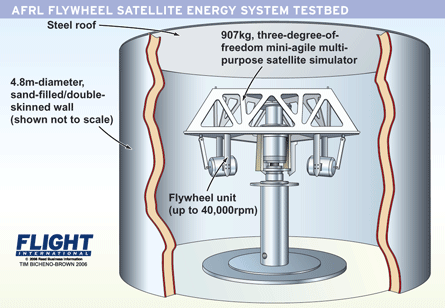Rob Coppinger / London
 |
Demonstration of technology for combined attitude control and energy storage on satellites is planned to begin later this month with initial power tests on a single-flywheel unit.
The tests will lead to three flywheels being fitted to a satellite simulator in 2007 for an experiment that will see them spun up from 16,000rpm to 40,000rpm.
The tri-flywheel arrangement will store energy as momentum, supplying power through an electromagnetic drive system. Flywheels have been used as satellite positioning devices in the past.
This work is part of the US Air Force Research Laboratory (AFRL) vehicle directorate’s Flywheel Attitude Control, Energy Transmission and Storage (FACETS) project, which began five years ago.
Tests will use the Honeywell-built 907kg (1,995lb) mini-agile multipurpose satellite simulator at Kirtland AFB, New Mexico. Completed in February, the three-degree-of-freedom simulator sits on a pressurised air bearing.
With flywheel speeds reaching 40,000rpm, the FACETS experiment is being housed inside a 4.8m (16ft)-diameter cylindrical container with a double-skinned, 127mm-thick wall, filled with sand, and a steel roof with pressure-relief flaps.
Source: Flight International




















